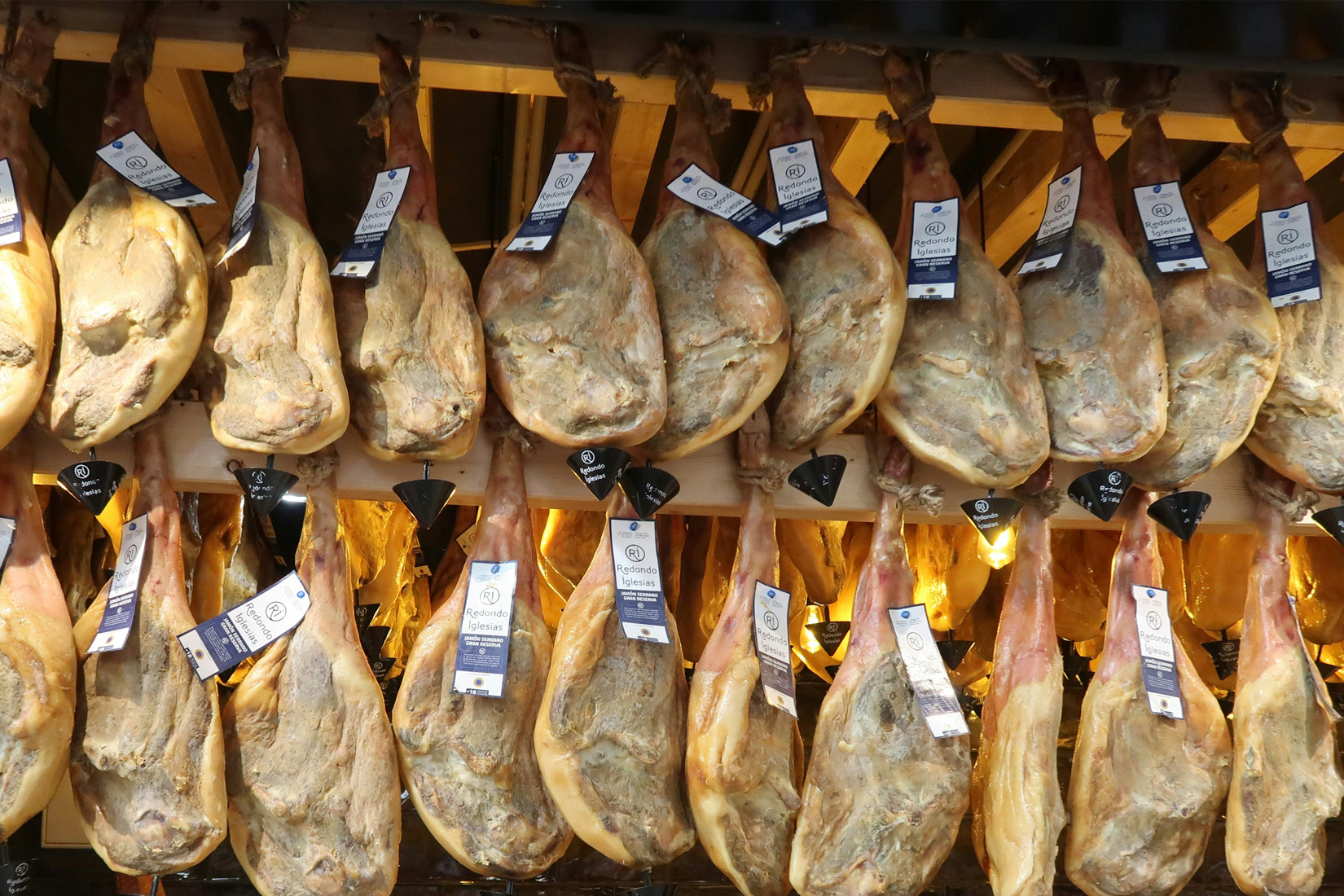
The Most Expensive Ham in the World
Few foods embody Spain’s soul as completely as its hams, and nowhere is that passion more intense than in Andalusia. From the wind-scoured oak pastures of Extremadura’s borderlands to the snow-dusted Alpujarra villages clinging to the southern slopes of the Sierra Nevada, curing legs of pork has been a way of life for centuries.
Here, the mingled aromas of mountain air, acorns, and wood-smoke drift through whitewashed drying sheds, promising two distinct treasures: the aristocratic, mahogany-laced Jamón ibérico de bellota whose fat melts like butter on the tongue, and the firmer, salt-kissed Jamón Serrano of Trevélez and beyond, each slice a postcard of Andalusia’s rugged land and time-slowed craft.
Jamón Serrano
Jamón Serrano (literally “mountain ham”) is Spain’s everyday cured delicacy, made from grain-fed white pigs (Duroc, Landrace, Pietrain) rather than the acorn-fattened black Iberian pigs. After a two-week salt cure and a rinse, the legs spend six to eighteen months drying in high-elevation secaderos, emerging with a rosy-to-purple colour, firm texture and a clean, gently salty flavour . Because there are no breed or regional restrictions, Serrano accounts for roughly 90 % of Spain’s annual ham output and carries EU “Traditional Specialty Guaranteed” status
Alpujarra corner of the Sierra Nevada adds its own twist. In villages such as Trevélez—perched above 1,400 m—producers take advantage of cold, dry mountain air to cure hams for 14–24 months with noticeably less salt. The pigs are locally raised on vegetable feeds, and the finished Jamón de Trevélez (a protected variety within the Serrano family) shows a delicate aroma, mild sweetness and suppler fat that reflects both the altitude and centuries-old artisan methods of the high Alpujarra.
Jamón Ibérico
Iberian ham, or Jamón Ibérico, is Spain’s most prized cured meat, produced from native black-hoofed Iberian pigs raised in the oak-studded dehesas of the southwest.
The animals roam freely for up to two years, fattening on acorns in autumn, which gives the ham its signature marbling and nutty aroma. After slaughter, legs are salted, dried, and cellar-aged for one to four years under strict quality rules that govern breed purity (minimum 50 % Iberian genetics), pasture size, and micro-climate. The top tier, Jamón Ibérico de Bellota 100%, is labelled “Pata Negra” and hails from official appellations such as Jabugo (Huelva), Guijuelo (Salamanca), Dehesa de Extremadura, and Los Pedroches (Córdoba).
The result is a glossy, deep-red ham with a silky texture and lingering flavor that commands prices well above €100 per kilo and is celebrated by chefs worldwide.
In Spain, people often call top Ibérico ham “pata negra,” literally “black hoof.” Here’s a twist: Manchado de Jabugo pigs frequently have white or depigmented hooves. In other words, this ultimate pata negra doesn’t always have a black foot. What matters is the breed, diet, and curing – the real drivers of quality.
An Andalucian Icon
When most people think of Spain’s finest ham, their minds jump to the classic strongholds of Extremadura or Salamanca. But if we’re talking price, the crown currently sits farther south, in Andalusia. Not too far from Sevilla, in the nearby Huelva region, you’ll find a ham so rare and so carefully crafted that it is priced at over 4,500 euros per leg (typically around 7-8kg).
It all begins with the animal. The Manchado de Jabugo is a rare strain of Ibérico pig, traditionally tied to the dehesa ecosystem of Huelva and now considered at risk of extinction. The breed grows slowly and lives in freedom, roaming oak-dotted pastures (montanera) to feast on acorns, grasses, and wild herbs. That acorn-rich diet, combined with the pigs’ genetics, produces a distinctive, buttery intramuscular fat that sets great Ibérico apart.
Patience is the second ingredient. Dehesa de Maladúa, the family behind this ham, works under certified organic standards and prioritises sustainability at every stage. From birth through the final curing, the process can span up to a decade. The hams then rest and evolve for a minimum of 48 months, with select pieces maturing much longer, sometimes up to six years in the cellar. The extended curing, meticulous salting, and slow drying concentrate aromas and develop the silky, nutty depth that aficionados chase.
The DOP Jabugo seal guarantees origin and methods and the designation marks the top tier within that system. Meanwhile, local institutions in Huelva have stepped up conservation efforts to protect this unique lineage and its habitat, another reason supply is tiny and prices reflect true scarcity.
Jamon from Huelva
Iberian hams from Huelva generally command both high prices and highest quality, with the 100% acorn-fed Ibérico hams from Jabugo being the most expensive. These hams are easy to identify because they bear a tamper-proof seal whose colour varies by sales designation. For 100% acorn-fed Ibérico ham, as established by Royal Decree 4/20/2014, the seal must be black. There are also blue, green, and red seals; the red ones are the next most expensive after the black.
In any case, the Protected Designation of Origin (PDO) Jabugo applies to ham produced in the province of Huelva, specifically in the Sierra de Aracena and Picos de Aroche Natural Park. These hams come from Iberian-breed pigs raised in complete freedom on the dehesa. Other protected designations for high-end hams include Los Pedroches, Jamón de Guijuelo, and Dehesa de Extremadura. All of them are exquisite and highly prized both in Spain and abroad.
Jamon Wine Pairing
Try a dry Fino or Manzanilla sherry, a well-structured Cava, or a restrained, high-acid white.

Mark
Really something to chew on for my next Andalucian trip!